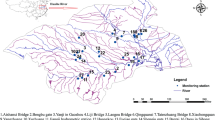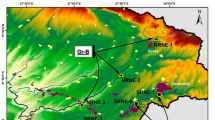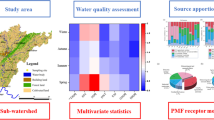Abstract
Surface water monitoring networks play an important role in the stream water quality management. Since a time series of data is obtained from the monitoring network, multivariate statistical techniques can be used to identify important factors or pollution sources of water system. Positive matrix factorization (PMF) is an improved factor analysis tool that has had limited application to water systems. The objective was to apply PMF to monitoring data to apportion water pollution sources in the Daliao River (DLR) basin. The DLR basin includes the Hun and Taizi River catchments in northeast China. This basin is densely populated and heavily industrialized. Fourteen monitoring stations located on the two rivers were used for monitoring 13 physical and chemical parameters from 1990 to 2002. Results show that five sources/processes in the Hun River and four in the Taizi River were identified by marker species and spatial-temporal variations of resolved factors, including point and nonpoint sources for both rivers. In addition, the industrial pollution source emission inventory data were used to compare with the resolved industrial sources. Results reveal that chemical transformations have influenced some chemical species. However, this influence is small compared with observed seasonal variations. Therefore, identification of pollution point and nonpoint sources by their seasonal variations is possible, which will also aid in water quality management. The spatial variation of the industrial pollutants typically corresponded with the urban industrial pollution source inventories.





Similar content being viewed by others
References
Anttila, P., Paatero, P., Tapper, U., & Jävinen, O. (1995). Source identification of bulk wet deposition in Finland by positive matrix factorization. Atmospheric Environment, 29, 1705–1718.
Bellos, D., Sawidis, T., & Tsekos, I. (2004). Nutrient chemistry of River Pinios (Thessalia, Greece). Environment International, 30, 105–115.
Brion, G., Brye, K. R., Haggard, B. E., West, C., & Brahana, J. V. (2011). Land-use effects on water quality of a first-order stream in the Ozark highlands, Mid-southern United States. River Research and Applications, 27(6), 772–790.
Busca, G., Berardinelli, S., Resini, C., & Arrighi, L. (2008). Technologies for the removal of phenol from fluid streams: a short review of recent developments. Journal of Hazardous Materials, 160(2–3), 265–288.
Carey, R. O., Migliaccio, K. W., & Brown, M. T. (2011). Nutrient discharges to Biscayne Bay, Florida: trends, loads, and a pollutant index. Science of the Total Environment, 409(3), 530–539.
Carrer, S., & Leardi, R. (2006). Characterizing the pollution produced by an industrial area chemometric methods applied to the Lagoon of Venice. Science of the Total Environment, 370, 99–116.
Diya’Uddeen, B. H., Daud, W. M. A. W., & Abdul Aziz, A. R. (2011). Treatment technologies for petroleum refinery effluents: a review. Process Safety and Environmental Protection, 89(2), 95–105.
Du, S., Belton, T. J., & Rodenburg, L. A. (2008). Source apportionment of polychlorinated biphenyls in the tidal Delaware River. Environmental Science and Technology, 42(11), 4044–4051.
Garcia-Pintado, J., Martinez-Mena, M., Barbera, G. G., Albaladejo, J., & Castillo, V. M. (2007). Anthropogenic nutrient sources and loads from a Mediterranean catchment into a coastal lagoon: Mar Menor, Spain. Science of the Total Environment, 373(1), 220–239.
Gobeil, C., Rondeau, B., & Beaudin, L. (2005). Contribution of municipal effluents to metal fluxes in the St. Lawrence river. Environmental Science and Technology, 39(2), 456–464.
Guo, W., He, M. C., Yang, Z. F., Lin, C. Y., Quan, X. C., & Wang, H. Z. (2007). Distribution of polycyclic aromatic hydrocarbons in water, suspended particulate matter and sediment from Daliao River watershed, China. Chemosphere, 68, 93–104.
Henry, R. C. (2003). Multivariate receptor modeling by N-dimensional edge detection. Chemometrics and Intelligent Laboratory Systems, 65, 179–189.
Henry, R. C., & Christensen, E. R. (2010). Selecting an appropriate multivariate source apportionment model result. Environmental Science and Technology, 44(7), 2474–2481.
Henry, R. C., Lewis, C. W., Hopke, P. K., & Williamson, H. J. (1984). Review of receptor model fundamentals. Atmospheric Environment, 18(8), 1507–1515.
Hopke, P. K. (2000). A guide to positive matrix factorization. In R. D. Willis (Ed.), Workshop on UNMIX and PMF as applied to PM2.5; 600/A-00/048. Research Triangle Park: U.S. Environmental Protection Agency.
Hopke, P.K., (2010) The application of receptor modeling to air quality data. Pollution Atmospherique.
Huang, J. L., Ho, M. H., & Du, P. F. (2011). Assessment of temporal and spatial variation of coastal water quality and source identification along Macau peninsula. Stochastic Environmental Research and Risk Assessment, 25(3), 353–361.
Joshi, U. M., & Balasubramanian, R. (2010). Characteristics and environmental mobility of trace elements in urban runoff. Chemosphere, 80(3), 310–318.
Kirk, P. W. W., & Lester, J. N. (1984). Significance and behaviour of heavy metals in wastewater treatment processes IV. Water quality standards and criteria. Science of the Total Environment, 40(1), 1–44.
Li, S., & Zhang, Q. (2011). Response of dissolved trace metals to land use/land cover and their source apportionment using a receptor model in a subtropic river, China. Journal of Hazardous Materials, 190(1–3), 205–213.
Mortvedt, J. J. (1996). Heavy metal contaminants in inorganic and organic fertilizers. Fertilizer Research, 43(1–3), 55–61.
Norris, G., & Vedantham, R. (2008). EPA positive matrix factorization (PMF) 3.0 fundamentals & user guide. Washington: U.S. Environmental Protection Agency, Office of Research and Development.
Paatero, P., & Tapper, U. (1994). Positive matrix factorization—a nonnegative factor model with optimal utilization of error-estimates of data values. Environmetrics, 5(2), 111–126.
Pattinson, S. N., Garcia-Ruiz, R., & Whitton, B. A. (1998). Spatial and seasonal variation in denitrification in the Swale-Ouse system, a river continuum. Science of the Total Environment, 210(1–6), 289–305.
Rao, E., & Puttanna, K. (2000). Nitrates, agriculture and environment. Current Science, 79(9), 1163–1168.
Reff, A., Eberly, S. I., & Bhave, P. V. (2007). Receptor modeling of ambient particulate matter data using positive matrix factorization: review of existing methods. Journal of the Air and Waste Management Association, 57(2), 146–154.
Rogora, M. (2007). Synchronous trends in N-NO3 export from N-saturated river catchments in relation to climate. Biogeochemistry, 86(3), 251–268.
Simeonov, V., Stratis, J. A., Samara, C., Zachariadis, G., Voutsa, D., Anthemidis, A., Sofoniou, M., & Kouimtzis, T. (2003). Assessment of the surface water quality in Northern Greece. Water Research, 37(17), 4119–4124.
Singh, K. P., Malik, A., Mohan, D., & Sinha, S. (2004). Multivariate statistical techniques for the evaluation of spatial and temporal variations in water quality of Gomti River (India)—a case study. Water Research, 38(18), 3980–3992.
Soonthornnonda, P., & Christensen, E. R. (2008). Source apportionment of pollutants and flows of combined sewer wastewater. Water Research, 42(8–9), 1989–1998.
State Environment Protection Bureau of China. (1989). Methods of monitoring and analysis for water and wastewater (3rd ed.). Bei**g: China Environmental Science Press.
Stout, S. A., & Graan, T. P. (2010). Quantitative source apportionment of PAHs in sediments of Little Menomonee River, Wisconsin: weathered creosote versus urban background. Environmental Science and Technology, 44(8), 2932–2939.
Sundqvist, K. L., Tysklind, M., Geladi, P., Hopke, P. K., & Wiberg, K. (2010). PCDD/F source apportionment in the Baltic Sea using positive matrix factorization. Environmental Science and Technology, 44(5), 1690–1697.
Vázquez, I., Rodríguez-Iglesias, J., Marañón, E., Castrillón, L., & Álvarez, M. (2007). Removal of residual phenols from coke wastewater by adsorption. Journal of Hazardous Materials, 147(1–2), 395–400.
Vega, M., Pardo, R., Barrado, E., & Deban, L. (1998). Assessment of seasonal and polluting effects on the quality of river water by exploratory data analysis. Water Research, 32(12), 3581–3592.
Zhang, Y., Guo, F., Meng, W., & Wang, X. Q. (2009). Water quality assessment and source identification of Daliao river basin using multivariate statistical methods. Environmental Monitoring and Assessment, 152(1–4), 105–121.
Zhou, F., Huang, G. H., Guo, H., Zhang, W., & Hao, Z. (2007). Spatio-temporal patterns and source apportionment of coastal water pollution in eastern Hong Kong. Water Research, 41(15), 3429–3439.
Acknowledgments
This work was supported by the National Environmental Protection Public Welfare projects (No. 201109017). We are also grateful for Prof. Shuli Zhao for her valuable comments and suggestions.
Author information
Authors and Affiliations
Corresponding author
Electronic supplementary material
Below is the link to the electronic supplementary material.
ESM 1
(PDF 751 kb)
Rights and permissions
About this article
Cite this article
Li, H., Hopke, P.K., Liu, X. et al. Application of positive matrix factorization to source apportionment of surface water quality of the Daliao River basin, northeast China. Environ Monit Assess 187, 80 (2015). https://doi.org/10.1007/s10661-014-4154-2
Received:
Accepted:
Published:
DOI: https://doi.org/10.1007/s10661-014-4154-2




